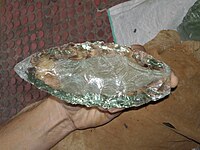Conchoidal fracture
This article needs additional citations for verification. (December 2009) |
A conchoidal fracture is a break or
.Crystalline materials such as quartz also exhibit conchoidal fractures when they lack a cleavage plane and do not break along a plane parallel to their crystalline faces. So, a conchoidal, or uneven, fracture is not a specific indication of the amorphous character of a mineral, or a material. Amorphous, cryptocrystalline, and crystalline materials can all present conchoidal fracture when they lack a preferential cleavage plane.
Conchoidal fractures can occur in various materials if they are properly percussed (struck). Cryptocrystalline silica, such as chert, or flint, with this material property were widely sought after, traded, and fashioned into sharp tools in the Stone Age.
Conchoidal fractures often result in a curved breakage surface that resembles the rippling, gradual curves of a
They are defined in contrast to the
Subsets
Several subdefinitions exist, for instance on the Webmineral website:[4]
- Brittle—conchoidal: very brittle fracture producing small, conchoidal fragments
- Brittle—subconchoidal: brittle fracture with subconchoidal fragments
- Conchoidal—irregular: irregular fracture producing small, conchoidal fragments
- Conchoidal—uneven: uneven fracture producing small, conchoidal fragments
- Subconchoidal: fractures developed in brittle materials characterized by semi-curving surfaces
Lithics
In
See also
References
- ^ Conchoidal fracture at Mindat.org
- ^ "Conchoidal". Merriam-Webster Online. Retrieved 2010-10-30.
- Perseus Project.
- ^ Mineral Tenacity and Fracture at Webmineral
External links
 The dictionary definition of conchoid at Wiktionary
The dictionary definition of conchoid at Wiktionary




